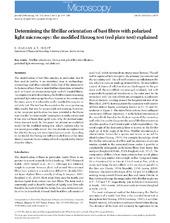| dc.contributor.author | Haugan, Einar | eng |
| dc.contributor.author | Holst, Bodil | eng |
| dc.date.accessioned | 2014-12-08T14:42:13Z | en_US |
| dc.date.accessioned | 2014-12-10T10:28:23Z | |
| dc.date.available | 2014-12-10T10:28:23Z | |
| dc.date.issued | 2013 | eng |
| dc.identifier.issn | 0022-2720 | en_US |
| dc.identifier.uri | https://hdl.handle.net/1956/8883 | |
| dc.description.abstract | The identification of bast fibre samples, in particular, bast fibres used in textiles, is an important issue in archaeology, criminology and other scientific fields. One of the characteristic features of bast fibres is their fibrillar orientation, referred to as Z- or S twist (or alternatively right- and left-handed fibres). Anempirical test for determining the fibrillar orientation using polarized light microscopy has been known in the community for many years. It is referred to as the modified Herzog test or red plate test. The test has the reputation for never producing false results, but also for occasionally not working. However, so far, no proper justification has been provided in the literature that the ‘no false results’ assumption is really correct and it has also not been clear up till now, why the method sometimes does not work. In this paper, we present an analytical model for the modified Herzog test, which explains why the test never gives a false result. We also provide an explanation for why the Herzog test sometimes does not work: According to our model, the Herzog test will not work if none of the three distinct layers in the secondary cell wall is significantly thicker than the others. | en_US |
| dc.language.iso | eng | eng |
| dc.publisher | JohnWiley & Sons Ltd on behalf of Royal Microscopical Society | en_US |
| dc.rights | Attribution CC BY | eng |
| dc.rights.uri | http://creativecommons.org/licenses/by/3.0/ | eng |
| dc.subject | fibrillar orientation | eng |
| dc.subject | Herzog test | eng |
| dc.subject | plant fibre identification | eng |
| dc.subject | polarized light microscopy | eng |
| dc.subject | red plate test | eng |
| dc.title | Determining the fibrillar orientation of bast fibres with polarized light microscopy: the modified Herzog test (red plate test) explained | en_US |
| dc.type | Peer reviewed | |
| dc.type | Journal article | |
| dc.date.updated | 2014-12-08T14:42:14Z | en_US |
| dc.description.version | publishedVersion | en_US |
| dc.rights.holder | Copyright 2013 The Authors. | en_US |
| dc.identifier.doi | https://doi.org/10.1111/jmi.12079 | |
| dc.identifier.cristin | 1066157 | |
| dc.source.journal | Journal of Microscopy | |
| dc.source.40 | 252 | |
| dc.source.14 | 2 | |
| dc.source.pagenumber | 159-168 | |
| dc.subject.nsi | VDP::Mathematics and natural scienses: 400::Physics: 430::Electromagnetism, acoustics, optics: 434 | en_US |
| dc.subject.nsi | VDP::Matematikk og naturvitenskap: 400::Fysikk: 430::Elektromagnetisme, akustikk, optikk: 434 | nob |

